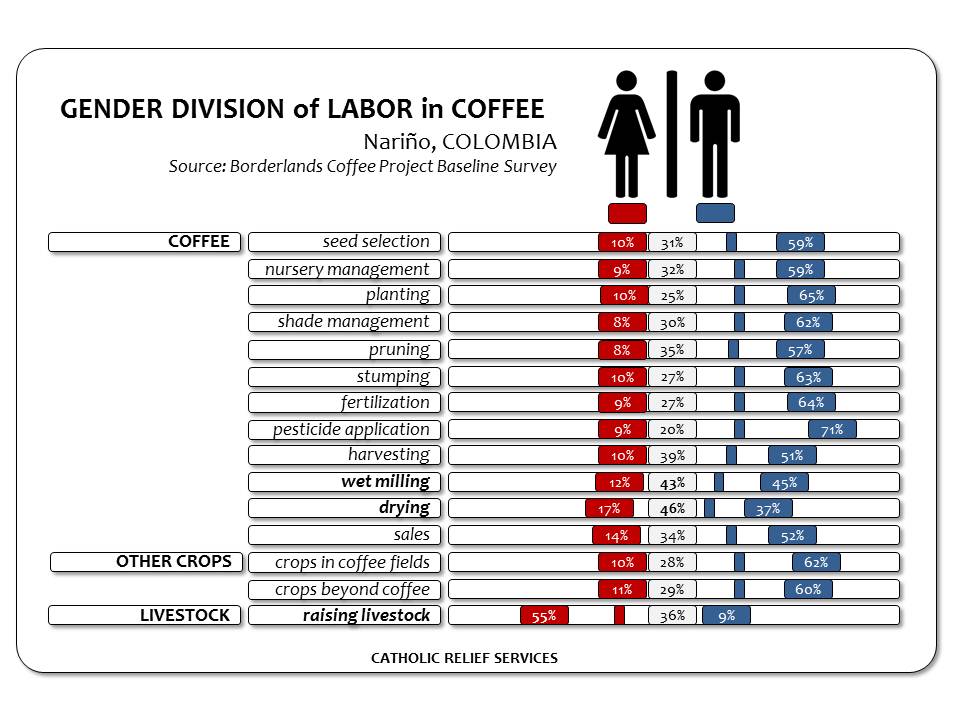Last week Root Capital published this issue brief on gender lens investing in the coffeelands. I posted some reflections on that publication here, and made reference to the fact that men and women experience the world differently as a result of the social construct of their respective gender roles.
The data we collected in Colombia as part of our Borderlands baseline survey show that men and women Nariño do, in fact, experience coffee farming differently. For most women, coffee is something they mill and dry in close proximity to their homes.
I remember taking a taxi home once when I was posted in the southern Philippines in my first job with CRS. The roads in the neighborhood where I lived were unpaved and unnamed. I gave the driver a landmark widely known in town–a mosque, I think it was–and then explained the route to my house from there in what I considered an intuitive way: left at the mosque, straight for two blocks, left again, etc. He considered it for a moment, smiled, then signaled his recognition of the route by imitating the noises his worn-car made as it navigated the ruts and rocks of the roads there: “Ah, yes. You mean the place where (clank) (crash) (boom)?”
We had different ways of knowing the same reality: me with a mental map and the right angles of a grid of streets and he with sensory perception expressed in sounds.
GENDER DIVISION OF LABOR.
The division of labor is pervasive in all areas of today’s highly specialized economy, and agriculture and coffee are no exceptions. Few people who participate in agriculture experience the full cycle directly; the crop-to-cup concept so familiar in coffee is a relay race, and coffee is a baton that passes from the hands of one specialized actor to the next in its long-distance course from farms in the coffee belt to cafés around the world. Very few coffee people perform more than a relatively narrow range of functions at a single link in the coffee supply chain. Even at the first link in the coffee chain–the farm–there is enough specialization that the farmers who grow our coffee may not experience all aspects of the processes it undergoes at the farm or at least may not experience them all with the same degree of intensity.
The division of labor on the farm, of course, often falls along gender lines. While the gender division of labor may not lead to a difference in ways of knowing as pronounced as the one described above, it does mean that men and women might “know” coffee production and processing differently.
WOMEN’S WORK in COFFEE: MILLING and DRYING.
The chart above is meant to show who performs which activities on the farm. The wide red bands with values displayed represent the percentage of households in which only women performed the corresponding task; the wide blue bands show the percentage of households in which the corresponding task is the domain of men; and the wide grey bands in the middle the percentage of households in which the task is performed jointly by men and women. The narrow blue and red bands show how “male” or “female” a particular task is on average: the further right the blue band the more “male” the activity; the further left the red band, the more “female” the activity.
What I find striking is the degree to which coffee farming in Nariño is men’s work. There isn’t a single coffee-related activity that is primarily women’s work. In fact, only two of the select coffee-related tasks included here even involve a majority of women: coffee milling and drying. Wet-milling is a joint activity in 43 percent of households and women’s work in 12 percent, meaning that in a majority of households (55 percent), women are involved in wet-milling. Drying coffee, similarly, is women’s work in 17 percent of households and a joint activity in 46 percent of households, meaning that in 63 percent of coffee-growing homes, women are involved in drying coffee. Most women in coffee-growing households, in other words, don’t plant coffee or prune it or even harvest it: only 49 percent are involved in harvesting, according to these data.
Perhaps most importantly given the body of research that shows women spend money in ways that tend to generate higher social returns than men, these data show that men tend to control the sale of coffee.
There are, of course, women-led households in which women perform all the tasks described here. (Meet some of the Borderlands project’s extraordinary women coffee farmers here.) But mostly (that is to say, in over half of all cases) women’s “productive” work in coffee is limited to milling and drying. There is a good reason for that–the pulpers and patios where coffee is milled and dried tend to be adjacent to the homes where women are often anchored by their “reproductive” duties, raising children and cooking.
This is the reason that women tend to have primary responsibility for raising small livestock, which in Nariño are likely to be chickens, pigs, guinea pigs or all three–they take up little space and corrals tend to be built on the same plots as farmers’ houses.
What does all this mean? That women and men in the coffeelands experience coffee differently. My sense is that efforts to increase women’s participation and promote gender equity in the coffee trade should take these different ways of knowing–and women’s dual “productive” and “reproductive” roles–into consideration.



